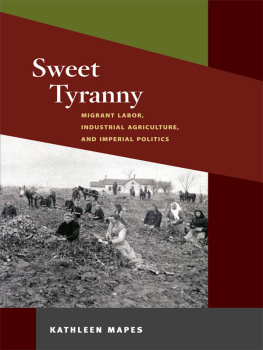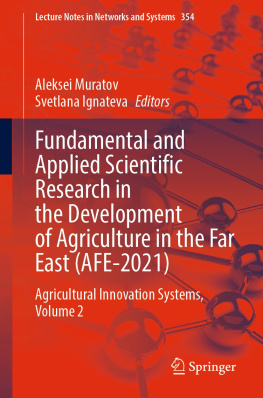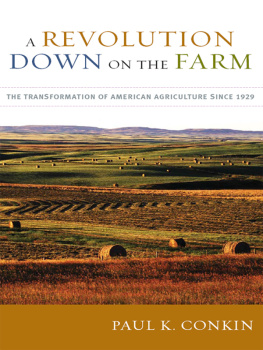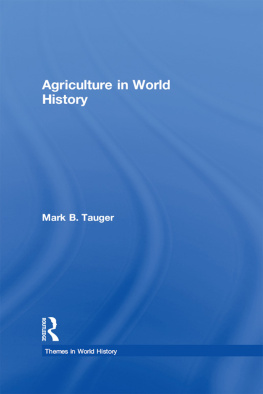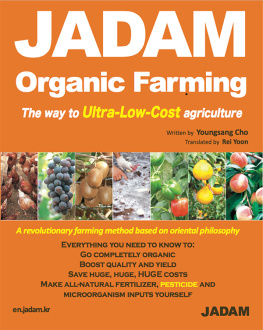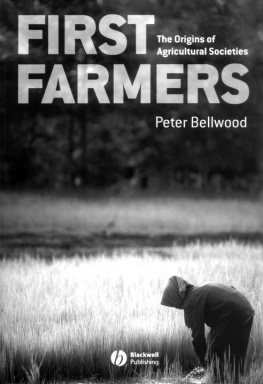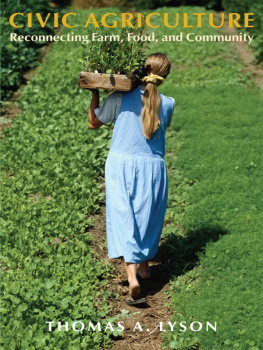The Farmers Benevolent Trust
1998 The University of North Carolina Press
All rights reserved
Manufactured in the United States of America
The paper in this book meets the guidelines for permanence and durability
of the Committee on Production Guidelines for Book Longevity of the
Council on Library Resources.
Library of Congress Cataloging-in-Publication Data
Woeste, Victoria Saker.
The farmers benevolent trust: law and agricultural cooperation in
industrial America, 18651945 / Victoria Saker Woeste.
p. cm.(Studies in legal history)
Includes bibliographical references and index.
ISBN 0-8078-2421-6 (cloth: alk. paper).
ISBN 0-8078-4731-3 (pbk.: alk. paper)
1. Agriculture, CooperativeLaw and legislationUnited StatesHistory. 2. Raisin industryLaw and legislationCaliforniaHistory. 3. California Associated Raisin Company. I. Title. II. Series.
KF1715.W64 1998
346.730668dc21 97-32599
CIP
02 01 00 99 98 5 4 3 2 1
THIS BOOK WAS DIGITALLY PRINTED.
For Keith and Helen
The welfare of this whole community is so bound up in the prosperity of the raisin business, and the progress of that business is so dependent on organized and more or less public action, that raisin affairs have always been treated, and properly treated, as public affairs.... The raisin industry, in this community, can not be treated, and never has been treated, as business in that narrowly private sense.
CHESTER H. ROWELL, EDITOR, FRESNO REPUBLICAN, 1909
Contents
Illustrations, Maps, and Figures
Sunkist advertisement, Ladies Home Journal, February 1919
An early Fresno raisin-packing plant, ca. 1890
Raisins drying in the Sun, ca. 1900
Raisins drying in sweat boxes, 1940
Armenian immigrants harvesting wine grapes, ca. 1885
Formal portrait of M. Theo Kearney, 1903
Meeting of the California Raisin Growers Association, 1900
Kearney riding in chauffeur-driven limousine, Paris, 1904
James Madison and Wylie M. Giffen in the CARC offices, 1914
James Madison with Sun-Maid girls, 1916
Early CARC advertisement for Sun-Maid Raisins, December 1915
CARC advertisement, Ladies Home Journal, October 1917
California Associated Raisin Company brokers and salesmen, 1916
Women workers packing raisins in CARC plant, 1917
Growers signing contracts in CARC offices, 1917
Aerial view of Sun-Maid plant, Fresno, 1936
MAPS
1. California agricultural production regions, 1909
2. Fresno County, California, ca. 1920
3. Agricultural colonies in Fresno County, ca. 1875
4. Sun-Maid plants, receiving stations, and unit divisions, 1923
FIGURES
A.1. Farm Size in Fruit-Growing and Nonfruit-Growing Counties in California, 1910
A.2. Farm Size in Fruit-Growing and Nonfruit-Growing Counties in California, 1920
A.3. Farm Size in Fruit-Growing and Nonfruit-Growing Counties in California, 1930
A.4. Farm Size in Fruit-Growing and Nonfruit-Growing Counties in California, 1940
Tables
1.1. California Raisin Production, in Tons, 18841898
2.1. Average and Median Farm Size in California, 18601940
2.2. Farm Size in Five Fruit-Growing Counties, 1900 and 1920
2.3. Proportion of Armenians in the Populations of Four Raisin-Growing Counties, 19001920
2.4. Armenian and Total Populations in Raisin Industry Towns, 19181920
4.1. California Raisin Production, in Tons, 18991913
6.1. Trustees of the California Associated Raisin Company and Their Occupations, 19121918
6.2. Financial Condition of the California Associated Raisin Company, 19141920
6.3. Average Retail Prices of Raisins in the United States, 19151928
6.4. The California Raisin Crop, the CARCs Share of the Raisin Crop, and Prices Paid to Growers, 19121920
7.1. CARC Prices to Growers and Wholesalers for Muscat Raisins, in Cents per Pound, 19141920
8.1. Sun-Maids Share of the California Raisin Crop, in Tons, 19211929
8.2. Sun-Maids Prices to Growers, in Cents per Pound, 19201929
8.3. Armenian Growers Withdrawing from Sun-Maid, by County, 1924
A.1. Numbers of Farms in California, by Size (in Acres), 18601940
A.2. Top Fruit-Producing Counties in California and Value of Crops Produced, in Dollars, 19101940
A.3. Top Field-Crop-Producing Counties in California and Value of Crops Produced, in Dollars, 19101940
A.4. Farm Size in Four California Fruit-Growing Counties, 19001940
A.5. Correlations between Farm Size (in Acres) and Value of Fruit Crop Production in California Counties, 19101940
A.6. Correlations between Farm Size (in Acres) and Value of Field Crop Production in California Counties, 19101940
A.7. Correlations between Total Number of Farms and Fruit and Field Crop Production among All California Counties, 19101940
A.8. Operators of Farms in California, 19101940
Acknowledgments
I take great pleasure in performing the authors ritual declaration of intellectual and personal debts.
The American Bar Foundation in Chicago, where I have the good fortune to work, has provided me with generous support and a convivial environment in which to write. Bryant Garth, director of the ABF, has encouraged my interests and projects, supplied wise insights into the academic world, and supported my career in important ways. My ABF colleagues have created an academic community that is without peer; I look forward to resuming my participation in the lively conversations at bagel time. I especially thank Carol Nielsen and Roz Caldwell of the ABF support staff for their efficiency and dedication.
I would be remiss if I did not acknowledge the members of my dissertation committee who did so much to shape the books eventual direction. The topic was originally the idea of Morton Rothstein; his continued friendship and support over the years keep me in his debt. Jim Gregory and Martin Shapiro raised questions that I am still thinking about years later. My adviser, Harry Scheiber, has supplied advice, criticism, and mentoring over the years; I am proud to count myself among his students.
The manuscript began the arduous process of becoming a book under the steady guidance of Thomas Green, co-editor of the Studies in Legal History Series. Very early on Tom expressed interest in publishing my book and waited patiently as I thought through the conceptual and historical issues he challenged me to address. When Dirk Hartog joined the editorial team, he spent hours talking with me about the books possibilities and shepherded the manuscript through formal review. Comments from the outside reviewer, Dan Rodgers, helped me to sharpen the focus of the first part of the book. Lewis Bateman of the University of North Carolina Press has been unstinting in his enthusiasm for the book; I have benefited from his many years of editorial experience and his vantage on the profession.
I imposed on many friends and colleagues to read chapter and manuscript drafts. My thanks to Ann Fidler, David Hounshell, Laura Kalman, David Morrison, Janice Okoomian, John Sayer, Art Stinchcombe, Christopher Tomlins, and Barbara Leibhardt Wester for their close readings and vital help. I wish as well to acknowledge the contribution of participants at seminars where I have presented parts of the book: the Five College Social History Seminar at Smith College; the Boston University Law School Legal History Seminar; the Legal History Workshop sponsored by the Center for Comparative Legal History at the University of Chicago; the Law, Deviance, and Society Research Colloquium of the Department of Sociology, University of Wisconsin, Madison; and the Economic History Workshop at Northwestern University.



